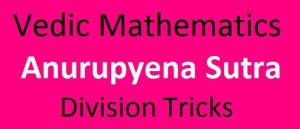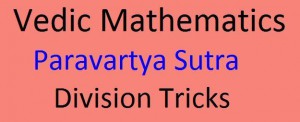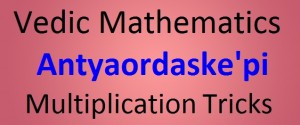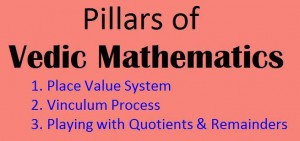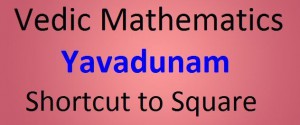Anurupyena & Vinculum Division using Vedic Mathematics when Nikhilam and Paravartya is not possible to be applied BUT if divisor is either multiplied or divided by some factor then it is possible. Anurupyena Sutra Division As seen earlier in Multiplication, Anurupyena means Proportion. Topics need to be known before starting: In this topic I will let you know the shortcut to divide numbers using Anurupyena Sutra. But before checking Anurupyena Methos below concepts are required. Basic Requisites page. Anurupyena method from Multiplication Nikhilam Method of Division Paravartya Specific Condition Required: As we know the meaning of Anurupyena (as proportion/ratio), we multiply/divide by factor to make divisor closer to larger number (To apply Nikhilam) OR to make closer to smaller number (To apply Paravartya). Later we multiply/divide QUOTIENT with same factor. Also Read => More Division Sutras in Vedic Mathematics Anurupyena Division Tricks: Its always good to use factors for multiplication instead of division because if division is used then on dividing Quotient by that factor might create non-integer i.e. a decimal quotient. To avoid overheads its better to use multiplication. It might follow or followed by Vinculum for simplicity purpose. Vinculum As seen earlier with bigger digits, calculation/process gets little bulky. So using Vinculum we need to convert bigger digits to smaller. Prerequisites: Vinculum and How to Play with Quotients and Remainders. Nikhilam and Paravartya Methods of Division As discussed earlier when we have larger divisor we apply Nikhilam and when we have smaller divisor we apply Paravartya. But when we have 1 or more larger digits (6,7,8,9) in divisor then calculating answer becomes little lengthy/time consuming also big multiplications are to be done. So we can convert such divisors in Vinculum Number. Example: # 2621/828 For already seen this example in … [Read more...]
Paravartya – Division using Vedic Mathematics
Paravartya Yogayat (Paravartya) Division in Vedic Mathematics when Divisor is CLOSER and SLIGHTLY GREATER than power of 10. Sanskrit Name: परवर्त्य योजयेत् English Translation: Transpose and Apply. Prerequisites: In this post I will guide you to shortcut to divide numbers using Paravartya Sutra. But before starting with Paravartya Sutra of Vedic Mathematics, below basic concepts are required. Vinculum & Concept of Playing with Quotients and Remainders Specific Condition Required: Lets see the what Paravartya Division Tricks are required in this Sutra. We apply this method when the Divisor is greater than power of 10 (10,100,1000, etc) and starts with 1. (The Divisor Need NOT to be JUST GREATER than power of 10 since large digits(6,7,8,9) can be converted to smaller digits(1,2,3,4) using Vinculum. Also if Divisor starts with other than 1 then we can apply Anurupyena Sutra. (see in Anurupyena & Vinculum)) As the name (Transpose and Apply) suggests we change the sign and apply the changed number. i.e. Addition will be turned to Subtraction , Division will be changed to Multiplication and vice versas. Remainder Theorem and Horner’s process of Synthetic Division are small parts of Paravartya Sutra. Also Check => More Division Sutras in Vedic Mathematics Examples: # 432/11 Discard the 1st digit(1) of Divisor(11) and take Transpose of remaining digits(i.e. -1 or Bar 1). Split Dividend in 2 parts (Quotient & Divisor) in such a way that Remainder part should have same number of digits thus obtained in 1st step.Thus remainder part will have only 1 digit Now carry the same process as done with previous (Nikhilam) method. If any bar digit is present in final answer, convert to Normal method using Vinculum. As seen instead of dividing we multiply and 11’s 1 is turned to -1 (i.e Transpose and Apply). As seen from last example (1356/182), using same above method we had to … [Read more...]
Antyaordasake’pi – Trick for Multiplication in Vedic Mathematics
Antyaordasake’pi: Multiplication using Vedic Mathematics when last digits of both numbers totals as 10*. Sanskrit Name: अन्त्ययोर्दशकेऽपि English Translation: Last Totaling as 10. Specific Condition Required* for applying Antyaordasake’pi sutra: Total of last digits of numbers is 10. Remaining previous numbers are same. Also Read => More Vedic Mathematics Sutras for Multiplication. Examples: Steps: Check if addition of last digits of the numbers is 10. If yes, multiply them and write in 2nd compartment. Apply Ekadhikena Purvena for the remaining digits i.e. Add 1 to the remaining digits. Eg: In case of 112 x 118, Apply Ekadhikena Purvena on 11 so we have 12. Now multiply 11 and 12 in write in the 1st compartment. … [Read more...]
Basic Requisites – Basics of Vedic Mathematics
While studying Vedic Mathematics, I came across some of the important concepts which forms base for most of those techniques. So before actually going through Vedic Mathematics techniques we need understand the basics used. I have collected all these concepts and named them as Basic Requisites for understanding and learning Vedic Mathematics. Basics of Vedic Mathematics: Place Value System Vinculum Numbers (English Meaning: Complement of a Number). Work with Quotients & Remainders. 1. Place Value System: It denotes the value present at particular place. Place Value concept is used for Vinculum Numbers (For conversion of Vinculum Numbers to normal numbers and vice versa). Example: 2345 5 is present at Units place. Hence Place Value of 5 is 5. 4 is present at Tens place. Hence Place Value of 4 is 40. 3 is present at Hundreds place. Hence Place Value of 3 is 300. 2 is present at Thousands place. Hence Place Value of 2 is 2000. Hence 2345 = 2000 + 300 + 40 + 5 2. Vinculum Numbers: Vinculum means bar(line) present over the symbol/digit. Sanskrit Name: विनक्ल्म् English Translation: Complement of a number. Vinculum Process or Vinculum Numbers are the very basics of Vedic Mathematics. Vinculum Numbers is concept used in Vedic Mathematics and are those numbers which have atleast 1 digit which is negative (having bar over them). Also called as Bar Numbers. As seen earlier Normal Number can be written as 2345 = 2000 + 300 + 40 + 5 Similarly Vinculum Numbers can be written as and can be converted to normal numbers as below: Another Approach for converting Vinculum Number to General Number, I generally remember this from R --> L as below (for better approach watch my below Video "Vedic Mathematics -1 (Vinculum 1of3)"). Convert 1st Bar digit from Right side to Normal digit (By taking its 10's complement) Decrement the previous digit by 1 (If it comes negative then repeat these … [Read more...]
Yavadunam – Shortcut to square a number in Vedic Mathematics
Yavadunam Tavadunikritya Varga Yojayet Shortcut method in Vedic Mathematics to square a number when it is closer to power of 10 (10/100/1000...) Commonly called as Yavadunam Sutra Sanskrit Name: यावदूनम् तावदूनी्क्रूत्य वर्ग च् योजयेत् English Translation: Square its Deficiency i.e. Whatever the extent of its deficiency/excess is, reduce/increase it still further to that extent and also square its deficiency/excess. Specific Condition Required: Numbers need to be close* to power of 10 (10, 100, 1000, etc). Example with proof: 82 = (10-2)2 = 100 – 40 + 4 = 10(10-4) + 4 = 10(10-2-2) + 22 = 10(8-2) + 22 = (8-2)/22 = 64 {Where First term at tens place and last term at Units place} Also Check, more Shortcuts to Square a number in Vedic Mathematics. More Examples: 92 = (9-1)/12 = 8/1 = 81 Here 9 is 1 less than 10(Base 10), So deficiency =1 Reduce it still further to that extent, So (9-1) = 8. Square its deficiency, So 12 = 1 . Final Answer: 81 132 = (13+3)/32 = 16/9 = 169 Here 13 is 3 more than 10(Base 10), So Excess = 3 Increase it still further to that extent, So (13+3) = 16 Square its excessive, So 32= 9 Final Answer: 169 182 = (18+8)/82 = 26/64 = 32/4 = 324 Here 18 is 8 more than 10(Base 10), so Excess = 8 Increase it still further to that extent, So (18+8) = 26 Square its excessive, So 82= 64. As we are using Base 10, 6 gets carry forwarded to other side. Final Answer: 324 Similarly, Trick to square number using Yavadunam which is closer to 100/1000 (Base 100/1000) is: 932= (93-7)/72 = 86/49 = 8649 892= (89-11)/112 = 78/121 = 7921 1132 = (113+13)/132 = 126/169 = 12769 10022 = (1002+2)/22 = 1004/004 = 1004004 httpv://youtu.be/S7G1uAK6c-s … [Read more...]
